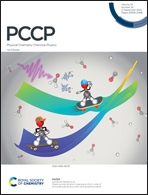Preparation of vibrational quasi-bound states of the transition state complex BrHBr from the bihalide ion BrHBr−†
Abstract
Efficient strategies that allow the preparation of molecular systems in particular vibrational states are important in the application of quantum control schemes to chemical reactions. In this paper, we propose the preparation of quasi-bound vibrational states of the collinear transition state complex BrHBr, from vibrational states of the bihalide ion BrHBr−, that favor the bond selective breakage of BrHBr. The results shown complement the investigation that we reported in a previous paper, [A. J. Garzón-Ramírez, J. G. López and C. A. Arango, Int. J. Quantum Chem., 2018, 24, e25784], in which we demonstrated the feasibility of controlling the bond selective decomposition of the collinear BrHBr using linear combinations of reactive resonances. We employed a dipole moment surface, calculated at the QCISD/d-aug-cc-pVTZ level of theory, to simulate the interaction of the BrHBr− ground vibrational state with heuristically optimized sequences of ultrashort infrared linear chirped laser pulses to achieve a target vibrational state, resulting from expanding a chosen linear combination of reactive resonances of BrHBr in terms of vibrational eigenstates of BrHBr−. The results of our simulations show final states that capture the most relevant features of the target state with different levels of description depending on the sequence of laser pulses employed. We also discuss ways of improving the description of the target state and possible limitations of our approach.



 Please wait while we load your content...
Please wait while we load your content...